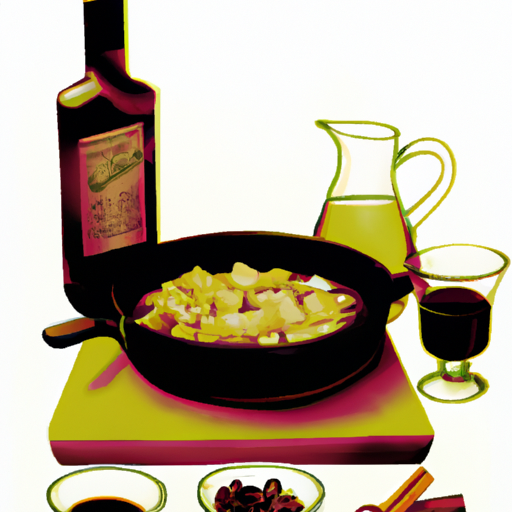Embark on a delightful journey through the captivating universe of food and folklore with Tastepan.com. Immerse yourself in the intriguing tales of culinary myths and legends, as we unravel the rich tapestry of food culture and traditions from around the world. Discover the fascinating histories behind regional cuisines and indulge in the delectable stories that will surely deepen your appreciation for the diverse flavors that adorn our plates. Get ready to feast upon the sumptuous heritage of food as we take you on an enchanting gastronomic adventure.

The Origins of Food Myths
Food myths have deep roots in ancient cultures, being passed down through generations as stories and legends. In ancient times, food was not just seen as sustenance, but also as a connection to the spiritual realm. Ancient Egyptians, for example, believed that certain gods and goddesses had dominion over specific food items. The story of the Egyptian goddess Isis and the quest for her husband Osiris’ body parts is one such example, where the search for his body parts was paralleled with the cultivation of wheat.
Food Myths in Ancient Cultures
Ancient Greeks and Romans also had their share of food myths. The story of Demeter and her daughter Persephone explains the changing seasons and the origins of agriculture. Demeter, the goddess of agriculture, grieved for her daughter’s disappearance, causing the earth to become barren until Persephone’s return. This myth reflects the connection between the harvest season and the cycle of life and death.
Folklore and Food Traditions
Food myths are not limited to ancient cultures. Throughout history, folklore has played a significant role in shaping food traditions. Folk tales often revolve around ingredients or dishes that hold mystical or magical properties. For instance, garlic has long been associated with warding off evil spirits in various folklore across cultures. These tales have led to the belief that consuming garlic can protect against vampires and other supernatural creatures.
The Role of Food in Myths and Legends
Food plays a central role in many myths and legends. It can symbolize abundance, fertility, power, and transformation. In Norse mythology, the gods ate the magical apples of Idun to maintain their eternal youth and immortality. These apples were considered divine and bestowed the gift of eternal life upon those who consumed them.
Food in myths and legends can also carry negative connotations. The Greek myth of Pandora’s box serves as a cautionary tale about the dangers of curiosity. When Pandora opened the box, she unleashed all the evils of the world, including diseases and hardships. This myth suggests that the act of indulging in forbidden food can lead to disastrous consequences.
The Power of Superstitions
Superstitions surrounding food have persisted throughout history and across cultures. These beliefs often stem from cultural traditions, religious customs, or personal experiences. Food taboos, lucky and unlucky foods, and superstitions surrounding cooking and eating are prevalent examples of these beliefs.
Taboos and Food Beliefs
Taboos regarding certain foods can be found in many cultures. For example, in Hinduism, the cow is considered a sacred animal, and consuming beef is strictly prohibited. Similarly, in Islamic dietary laws, pork is considered impure and is forbidden to be consumed. These food taboos are deeply ingrained in cultural and religious practices and are followed with utmost respect and adherence.
Lucky and Unlucky Foods
Many cultures believe in lucky and unlucky foods that can bring either good fortune or misfortune. For instance, in Chinese culture, noodles are considered lucky as they symbolize longevity. On the other hand, breaking a mirror while cooking or eating is believed to bring seven years of bad luck in some Western traditions.
Superstitions Surrounding Cooking and Eating
Superstitions surrounding cooking and eating are also prevalent. In some cultures, it is believed that cooking food while feeling angry or upset can transfer negative emotions to the dish, leading to an unpleasant dining experience. Similarly, there is a widespread belief that blowing out all the candles on a birthday cake in one breath will make your wish come true.

Legendary Ingredients and Recipes
Legends often feature ingredients or recipes that possess extraordinary properties. These mythical substances can range from elixirs of immortality to magical fruits and cursed dishes.
The Search for Immortality: The Legend of the Elixir of Life
One of the most enduring legends is the quest for the elixir of life, a mythical potion that grants eternal youth and immortality. The pursuit of this elixir has been depicted in various mythologies and legends, such as the Chinese legend of the Eight Immortals and their magical peaches of immortality. These legendary fruits were said to bestow longevity upon anyone who consumed them.
Magical Fruits and Vegetables
Magical fruits and vegetables are often featured in folklore and mythology. The golden apple in Greek mythology played a significant role in the judgment of Paris and the start of the Trojan War. Similarly, in the Indian epic Ramayana, the monkey god Hanuman brought back a life-giving herb to heal the wounded hero, Rama.
Cursed Dishes and Poisonous Delicacies
Legends also warn about cursed dishes and poisonous delicacies. In Arthurian legends, the knights set out on a quest to find the Holy Grail, a legendary cup believed to possess healing powers. However, there were also tales of cursed food and drinks that led to dire consequences, such as the poisoned apple that caused Sleeping Beauty’s long sleep.
Food in Fairy Tales and Children’s Stories
Food often features prominently in fairy tales and children’s stories, captivating young readers with its magical qualities and its ability to convey moral lessons.
Hansel and Gretel: The Power of Gingerbread
The story of Hansel and Gretel showcases the allure of gingerbread and its role as a symbol of temptation. The witch in the tale lures the children into her gingerbread house as a trap. This story serves as a cautionary tale about the dangers of gluttony and trusting unknown sources.
The Big Bad Wolf and Grandma’s Basket of Goodies
Little Red Riding Hood’s encounter with the Big Bad Wolf highlights the dangerous nature of appearances. The basket of goodies carried by Little Red Riding Hood symbolizes nurture and care. However, the wolf takes advantage of this trust to deceive her. This story serves as a reminder to be cautious and wary of those who may have ulterior motives.
The Role of Food in Moral Lessons
Food is often used as a tool to teach moral lessons in fairy tales and children’s stories. The story of The Boy Who Cried Wolf teaches the importance of honesty and not making false claims. The tale revolves around a young shepherd who repeatedly lies about a wolf attacking his flock, resulting in a loss of trust within the community.

The Culinary Legends of Heroes and Villains
Food plays a significant role in the legends of heroes and villains, showcasing their prowess, indulgence, and even their monstrous nature.
The Legendary Feasts of King Arthur and the Knights of the Round Table
The legends of King Arthur and the Knights of the Round Table often depict lavish feasts and banquets. These grand gatherings symbolize power, wealth, and hospitality. They serve not only as a display of abundance but also as a way to unite the knights and strengthen their bonds.
The Dark Side: Food Curses in Mythology
In contrast to the feasts of heroes, villains and dark forces often use food as a tool of deception and curses. In Greek mythology, the beautiful and enchanting nymph, Circe, uses her magical potions and poisoned delicacies to turn men into animals. This illustrates the treacherous nature of indulgence and the dangers that can accompany it.
Monsters and their Peculiar Food Preferences
Monsters and mythical creatures often have peculiar food preferences that reflect their otherworldly nature. The Greek monster, Cyclops, is famously known for consuming human flesh, while dragons in various cultural myths have a strong affinity for treasure, often guarding it fiercely.
The Mythical Origins of Food Rituals
Food rituals have long been an integral part of human civilizations, with myths providing explanations for these traditions.
Sacred Food Offerings to the Gods
Many ancient cultures believed in the practice of offering food to gods and deities. These offerings were made to seek favor, protection, and prosperity. For example, in ancient Greece, people would offer cakes and wine to the gods during religious ceremonies and festivals. These food rituals were seen as a way to establish a connection with the divine.
The Story behind Traditional Festive Foods
Traditional festive foods are often steeped in myths and legends. During Chinese New Year, the consumption of fish is considered auspicious as it signifies abundance and prosperity in the coming year. In Mexico, the Day of the Dead celebration involves the offering of sugar skulls, bread of the dead, and other symbolic foods to honor ancestors and guide their spirits back to the earthly realm.
The Connection between Food and Divination
Across cultures, there are rituals involving food that are linked to divination or predicting the future. For instance, in certain traditions, the cracking of an egg can reveal insights about a person’s destiny. Similarly, in Western folklore, apple peels are used for divination by tossing them over one’s shoulder and interpreting the shape they take.
Food and Love: Romantic Myths and Traditions
Food and love have been intertwined throughout history, inspiring romantic myths, traditions, and beliefs.
Aphrodisiacs and Love Potions
Certain foods have been attributed with aphrodisiac properties, believed to enhance desire and passion. Oysters, chocolate, and strawberries are popularly associated with romantic encounters. These foods have been celebrated as gifts of love and desire in various cultures.
The Drunkard and the Pomegranate: Love in Greek Mythology
In Greek mythology, the story of Persephone and Hades represents the eternal bond between love and food. Persephone consumed pomegranate seeds in the Underworld, binding her to Hades for a portion of the year. This myth explains the changing of seasons and serves as a reminder that love can have both joyous and difficult aspects.
Wedding Traditions Around the World
Wedding traditions often involve special foods and rituals that symbolize unity, fertility, and the start of a lifelong commitment. In some cultures, couples feed each other cake to symbolize their partnership, while in others, the breaking of a wedding cake on the bride’s head is believed to bring good luck and fertility.
The Influence of Food Myths on Culinary Traditions
Food myths have left a lasting impact on culinary traditions, shaping dietary practices, cooking techniques, and the preservation of cultural identity.
Food Taboos and Dietary Restrictions
Food myths and taboos have influenced dietary practices across different cultures, often leading to specific dietary restrictions. For example, in Hinduism, vegetarianism is widely practiced due to the belief in non-violence and the sanctity of all living beings. Similarly, kosher and halal dietary laws prescribe specific rules and restrictions for food preparation and consumption.
Traditional Cooking Techniques Passed Down Through Generations
Myths and legends have also played a role in preserving traditional cooking techniques. Recipes and methods passed down through generations often carry the weight of cultural heritage and are considered invaluable. These traditional cooking techniques enable communities to maintain their culinary identity and pass on their cultural heritage to future generations.
The Preservation of Cultural Identity through Food
Food plays a crucial role in preserving cultural identity, with myths and legends providing a foundation for culinary traditions. Traditional dishes, ingredients, and recipes are often seen as representations of a specific culture’s history, values, and heritage. By continuing to prepare and share these culturally significant foods, communities can maintain a sense of identity and connection to their roots.
The Modern-Day Impact of Food Myths and Legends
Food myths and legends continue to have an impact on modern-day society, influencing trends, marketing strategies, and culinary practices.
The Popularity of Superfoods: Fact or Fiction?
The concept of superfoods, foods believed to have exceptional health benefits, has gained significant popularity in recent years. While some superfoods do possess unique nutritional properties, others may be based more on marketing hype and exaggerated claims. It is important to critically evaluate the scientific evidence behind these claims to make informed dietary choices.
The Role of Food Myths in Marketing
Food myths and legends are often utilized in marketing strategies to create intrigue, evoke emotions, and drive sales. Companies may leverage the stories and associations surrounding certain foods to enhance their products’ perceived value and desirability. Understanding the stories behind these marketing tactics can help consumers distinguish between genuine quality and mere myth.
The Reinterpretation of Traditional Dishes in Contemporary Cuisine
Contemporary cuisine often draws inspiration from traditional dishes and techniques, incorporating innovative twists and modern interpretations. Chefs and food enthusiasts explore how myths and legends can be reinvented through culinary creativity, blending nostalgia with cutting-edge culinary techniques. This reinterpretation allows for the continuation of cultural traditions in an ever-evolving culinary landscape.
Uncovering the Truth: Debunking Food Myths
With the advancement of scientific knowledge, there is an increasing need to separate fact from fiction when it comes to food myths. Evidence-based research and critical analysis help debunk long-standing beliefs and provide accurate information about the impact of certain foods on health and nutrition.
Science vs. Myth: Separating Fact from Fiction
Scientific research plays a vital role in challenging and debunking food myths. Through rigorous studies, nutrition experts can evaluate the claims and beliefs surrounding various foods and determine their true effects on the body. By relying on evidence-based facts, we can separate scientific truths from myths and make informed decisions about our diets.
The Influence of Food Myths on Health and Nutrition
Food myths can have a profound impact on health and nutrition practices. Misinformation can lead to unnecessary dietary restrictions or the adoption of unproven fads, potentially causing imbalances and deficiencies in the diet. Understanding the science behind nutrition and debunking food myths is crucial for maintaining a balanced and healthy lifestyle.
Challenging Long-standing Beliefs with Evidence-Based Research
In an ever-evolving scientific landscape, challenging long-standing food beliefs is necessary to ensure accurate information and promote well-being. By embracing evidence-based research and questioning entrenched myths, we can expand our understanding of nutrition and make informed choices that benefit our overall health and well-being.
In conclusion, food myths and legends have permeated cultures throughout history, shaping culinary traditions, inspiring beliefs, and providing lessons. From ancient civilizations to modern-day societies, these myths continue to influence our perceptions of food, love, spirituality, and health. By exploring the origins and impact of these stories, we can appreciate the rich tapestry of flavors and cultural heritage that food brings to our lives.

